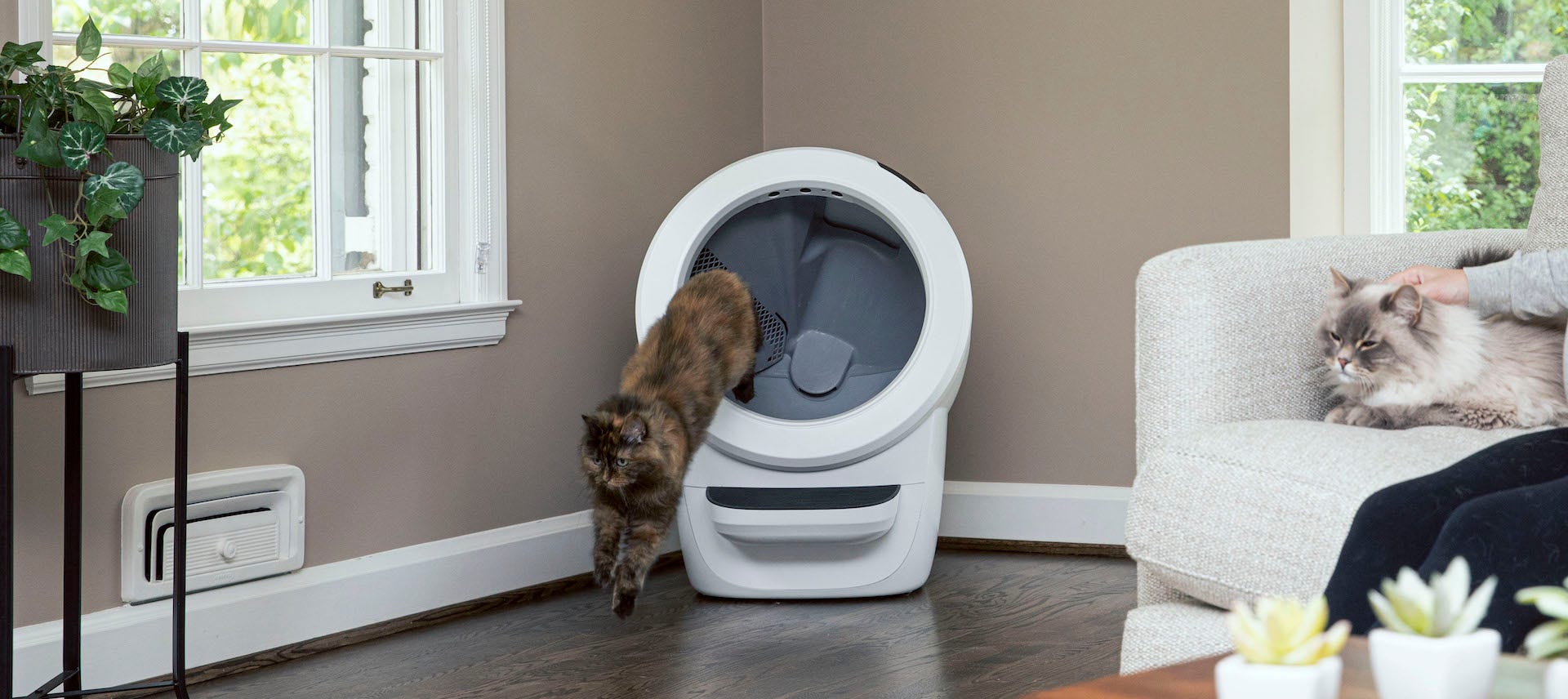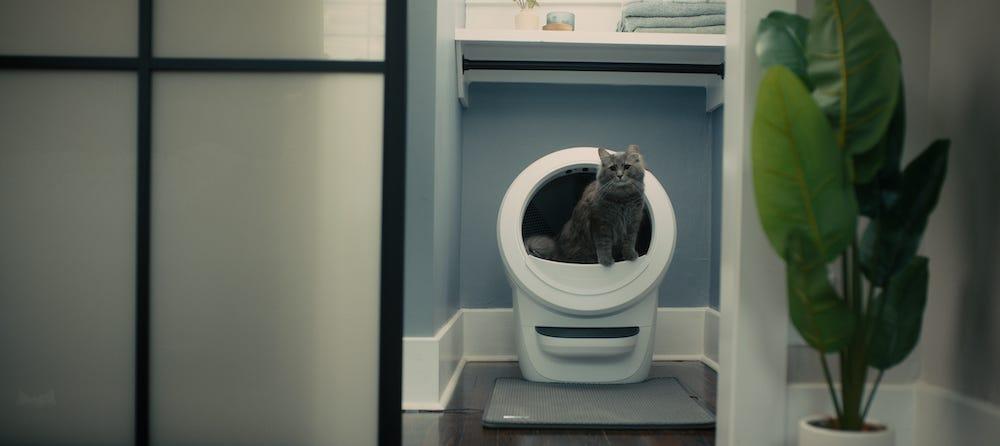Is your cat peeing blood? If you just found blood in the litter box, read on! As an emergency critical care veterinarian, I’m used to blood. But when I see it from my own cat, it definitely has me worried! So, if you all of a sudden notice blood in cat urine or blood from the rear end of your cat, you should get to a veterinarian because it needs to be addressed and fixed.
Blood in the litter box
First, it’s hard to differentiate if what you’ve noticed is bloody urine or feces or vomit. (So many orifices for the fluid to come from!) When in doubt, take a few pictures with your smartphone, and then suck some up (with a dosing syringe)—or worst case, wipe it up on a clean white paper towel and fold it into a plastic Ziploc bag—and bring it to your veterinarian. Gross as it sounds, we veterinarians want to see it and can often determine the source.
Take, for example, when one of my friends reached out concerned about their cat. They have a WiFi-enabled, self-cleaning Litter-Robot 3 Connect, and noticed this on the smartphone app:

This app shows the number of trips that their cat was making to the automatic litter box. You can see that this cat typically averages 2-3 visits to the Litter Robot per day. Then all of a sudden in a 2-day period, this poor kitty was visiting the litter box 14-16X/day. Woah! Cats normally visit the litter box 1-4X/day. If you see that many trips to the litter box, something is medically wrong, and a visit to the vet—even the ER vet in the middle of the night—is a MUST.
What causes blood in cat urine?
If you find your cat peeing blood or dripping bloody drops of urine around the house, PLUS making frequent trips to the litter box, then your cat likely has one of four conditions:
- Feline Idiopathic Cystitis (formerly known as Feline Lower Urinary Tract Disease or FLUTD)—also known as Feline Interstitial Cystitis (FIC) or Feline Urologic Syndrome (FUS); these all stand for the same thing, but the experts out there keep changing the name every few years!
- Feline Urethral Obstruction (e.g., a urinary blockage or “blocked” cat)
- Urinary Tract Infection (UTI)
- Bloody diarrhea (rarer) or even severe constipation
So, how do you know which of the 4 diseases your cat may have? In my previous blog Why a Clean Litter Box is Essential To Good Cat Health, I talked about Feline Idiopathic Cystitis (FIC) and the more life-threatening Feline Urethral Obstruction (FUO). Check out that blog for more details. What do I see commonly in the ER? The majority of the time, these urinary signs are due to a sterile inflammation of the bladder (FIC), or an FUO. Rarely, I’ll see bloody urine from a UTI.
Other symptoms
The signs of Feline Idiopathic Cystitis, a urinary obstruction, or even a UTI look pretty similar in cats and include the following:
- More than 1-4 trips to the litter box a day
- Excessive grooming of the genital area
- Squatting to urinate in front of you
- Urinating in weird places, like on plastic bags, on your laundry, in the bathtub or sink
- Discolored urine (e.g., blood-tinged)
- Absence of large clumps in the litter box
- Straining to urinate
- Acting painful (e.g., meowing or crying out when using the litter box)
- Abnormal-smelling urine
- Vomiting
- Lethargy
Diagnosing the cause of blood in cat urine
Once you’re at the veterinarian, a few tests are recommended. Ideally, the vet will start with a sterile urine sample collected by a cystocentesis (a sterile needle going through the body wall) to collect a urinalysis and culture if possible. Just to warn you, in my clinical experience, I’m only able to get a urine sample about 30% of the time in cats with Feline Idiopathic Cystitis, because the bladder is so small secondary to inflammation; if it’s that small, it may not be safe to obtain a sample.
Why is a urine sample so important?
We veterinarians are looking at how concentrated the urine is (normal urine specific gravity or “concentration” in cats is > 1.050). We also want to evaluate if there is evidence of white blood cells, red blood cells, crystals, or even bacteria on microscopic examination. If we do see crystals (such as struvite or calcium oxalate), we may need to put your cat on a permanent urinary-appropriate diet to dissolve these crystals. (That means no treats either!) Please keep in mind that you shouldn’t just randomly put your cat on these diets without consulting your veterinarian, as these two types of crystals dissolve in different urine acidities (e.g., pH), and it could potentially worsen your cat’s problem if the wrong diet is used.
Next, if the urine sample is sterile, we’ll want to do a urine culture; this is the most accurate way of determining if a true bacterial infection exists. This test (abbreviated as UC) takes several days to get the results back, as the urine is put onto a microbiology plate to see if certain types of bacteria grow. Typically, we’ll send your cat home on a few days of antibiotics until we get these culture results. Now keep in mind that UTIs are relatively rare in young cats—less than 2-5% of the time is it actually due to a bacterial infection (e.g., requiring antibiotics). That said, if your cat is middle-aged or older, urinary tract infections can be more prevalent, especially if underlying medical problems exist (such as diabetes mellitus, where there’s too much sugar in the urine, etc.). That’s why additional testing is necessary to rule out the source of blood!
Treating your cat’s condition
So, how are some of these problems treated?
- Feline Idiopathic Cystitis is treated on an outpatient basis, with fluids under the skin to help hydrate and flush out the bladder, pain medication, and canned food.
- Feline Urethral Obstruction (e.g., blocked cat) is treated with sedation, unblocking (by placing a urinary catheter), aggressive IV fluids, pain control, and appropriate monitoring and supportive care (including blood work, urine output monitoring, etc.).
- Urinary tract infections are often treated with a short course of antibiotics and pain medication.
When in doubt, if you notice your cat peeing blood or blood from the rear, get to a vet right away to keep your cat safe and pain-free. If you’re worried you’ll miss some of the subtler signs of Feline Idiopathic Cystitis (or worse), you may want to try a WiFi-enabled litter box to track your cat’s litter box habits from your phone.
Check out the video below: These pet parents didn’t know their cat was peeing blood until their app alerted them that the Litter-Robot was cycling every 10 minutes. (That’s the nice thing about technology: it allows us to be able to monitor our cat’s health remotely!)
Cover photo by Cong H on Unsplash






